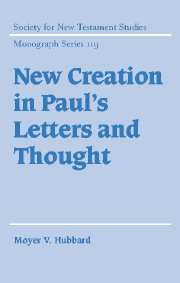Book contents
- Frontmatter
- Contents
- Acknowledgments
- List of abbreviations
- 1 Introduction: the current debate
- PART I NEW CREATION: CENTRAL JEWISH TEXTS
- Part II FROM DEATH TO LIFE: NEW CREATION IN THE CONTOURS OF PAUL'S THOUGHT
- Part III THE OLD AND THE NEW: NEW CREATION IN THE CONTEXT OF PAUL'S LETTERS
- References
- Index of passages cited
- Index of modern authors
PART I - NEW CREATION: CENTRAL JEWISH TEXTS
Published online by Cambridge University Press: 02 December 2009
- Frontmatter
- Contents
- Acknowledgments
- List of abbreviations
- 1 Introduction: the current debate
- PART I NEW CREATION: CENTRAL JEWISH TEXTS
- Part II FROM DEATH TO LIFE: NEW CREATION IN THE CONTOURS OF PAUL'S THOUGHT
- Part III THE OLD AND THE NEW: NEW CREATION IN THE CONTEXT OF PAUL'S LETTERS
- References
- Index of passages cited
- Index of modern authors
Summary
As indicated in the introductory comments, the interpretation of Paul's new-creation motif has been intimately connected with the Jewish context of the pre-Christian Paul, and this is a more than reasonable starting point. The primary concern here is to determine what (if any) Jewish antecedents might have exerted a formative influence on the apostle's conception of new creation. I have already provided a rationale for the selection of primary sources to be examined in part I, and more comment on this subject will be offered at the beginning of each section. While an adequate treatment of this theme requires a full analysis of a very select group of extra-biblical texts, close attention to the footnotes will reveal a broadly researched argument, with ample corroboration from the literature of the period.
Following a survey of this theme in the prophetic literature of the Hebrew Bible (chapter 2), I will look closely at the book of Jubilees (chapter 3) and Joseph and Aseneth (chapter 4). These sources provide evidence for a variety of applications of new-creation imagery in the literature and thought-world of first-century BC/AD Judaism, and each of these uses may be regarded as potentially influential on Paul the apostle. While it would be wrong to limit Paul to only these interpretive options, effectively disallowing his own creative intellect, it would be equally imprudent to examine Paul's letters in a historical vacuum. Original thinkers occasionally part company with their contemporaries, yet sometimes the better part of originality is a fresh reformulation of primitive faith.
- Type
- Chapter
- Information
- New Creation in Paul's Letters and Thought , pp. 9 - 10Publisher: Cambridge University PressPrint publication year: 2002



